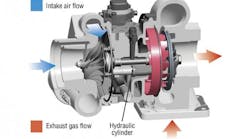Cast iron guard rings prevent leakage and extend life of cylinders.
Two cylinders for actuating the main boom have a 5.5-in. bore, 58.3- in. stroke, and 3.9-in. rod diameter. The arm cylinder has a 6.3-in. bore, 71.9-in. stroke, and 4.3-in. rod diameter. The bucket cylinder has a 5.5- in. bore, 50.6-in. stroke, and 3.9-in rod diameter. The cylinders are controlled through dual-spool valves with Komatsu’s Proportional Pressure Control (PPC) feature. PPC allows fine control and reduces the effort and travel distance the operator must execute to control the machine.
The reservoir must be sized to accommodate return fluid from all these cylinders at once. The entire hydraulic system requires 96.4 gal of fluid, and the reservoir holds 49.7 gal. This is a dramatic departure from reservoirs designed for stationary (industrial) equipment, where reservoirs are usually sized to hold one minute’s worth of maximum pump flow. The larger volume of industrial hydraulic reservoirs provides an opportunity for fluid to “rest” before being drawn back into the pump. This rest allows sufficient time for cooling, for air to rise to the surface of the fluid, and for heavy contaminants to settle.
Mobile equipment generally cannot benefit from these luxuries because repeated motion of the machine would prevent contaminants from settling and air from rising. Therefore, reservoirs in mobile equipment typically use baffles to reduce fluid turbulence, diffusers to promote deaeration, and heat exchangers.
Just the right touch
Maximizing efficiency and controlling all this power is left to Komatsu’s HydrauMind (Hydraulic Mechanical Intelligence New Design System) feature. HydrauMind is a closed-center system that uses pressure compensation and load sensing to optimize operation and energy efficiency of multiple functions simultaneously. HydrauMind uses simple electronic controls with sensitivity that can be adjusted to match work conditions.





